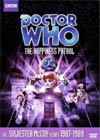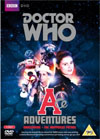DVD Extras include:
There are a lot of good things about this adventure. The Doctor's character is quite strong in this one, at least in terms of his abilities, and the adventure's many varied scenes appear to be packed full of psychological and social commentary, the stuff of really rich satire. But there are also two major problems with the tale. As is common with candy-horror stories, the rules of normal reality seem to be magically suspended to allow all the cute and sweet things to become so deadly - this time around perhaps not so much in terms of physics or chemistry, but more in terms of believing in the political set-up and its sociological continuation. Secondly, the plot is quite slippery. We get tons of characters moving around in a lot of short scenes, and most of the time one can't keep track of what's motivating them, or what they're specifically trying to accomplish with their movements from scene to scene. Part Two is particularly troubled, as the only reason why the Doctor curtails most of his meetings and scenes seems to be to arbitrarily delay resolution in any of them until they recur again in the final episode. As poignant as the satire may be at any moment, the audience easily remains at a loss to know who or what to emotionally invest in.
For me, the most important scene of the story is one that is built up to in early portions of Part Three, as most of the characters converge on a large square for a major confrontation. The whole plot turns here, and on a point that highlights the main theme of the piece. But sadly, the director and his actors and crew don't seem to have wrapped their heads around it very well, or are trying to cram it in before the studio shuts down at its 10:00 pm cut-off and they lose the set forever. Or both. This scene is so beautiful and perfect in the novelization, that it is an utter shame it was such a hack job on television. The key thing here is that members of the Happiness Patrol have become keen observers of human emotion, and they can recognize all the subtle distinctions between a person who is truly happy and a person who is faking it. These subtleties MUST be correct in the acting, or the scene can't function, and on TV, they totally didn't get it. The Doctor and all his friends need to be ecstatic and exuberant, for real, unshakably. But sadly, Sylvester McCoy is clearly faking it, over-the-top faking it at that, and most of his friends appear to be faking it in a lower-key as well. These are all good actors, capable of much better, but something went badly awry here. Apart from a few gaffes such as this, Sylvester McCoy otherwise performs quite well in the story, particularly opposite characters like Helen A or Trevor Sigma. I was quite pleasantly surprised how strong his Doctor was in this one. Other good performances to watch out for include Rachel Bell as fanatically serious Patrolwoman Priscilla P, along with Sheila Hancock as Helen A. I don't know if it has anything to do with drawing on imitation of then Prime Minister Margaret Thatcher, but both of these authoritative female performances seem to be miles better and more interesting than the cookie-cutter female villains we will later get in the New Millennium version of the show, or for that matter, in Tom Baker's debut in "Robot" (story no. 75). Lesley Dunlop also does really well with her sympathetic role of Susan Q, once more making a good buddy for a Doctor Who companion. Still, her role as Norna in "Frontios" (story no. 133) was a bit more interesting, and of course part of a better story. As for Ace herself, I think it shows that this story was the last one shot for season 25, as Sophie Aldred seems more relaxed and comfortable in the role, and her rapport with McCoy has gelled to a deeper level. Not that she wasn't excellent before, just that the fluidity of their relationship seems to have taken a quantum leap in between stories. Still, Ace doesn't get a lot of character-defining things to do here, as though you could just about swap in any generic Doctor Who companion into her role, and have it work equally well. John Normington, more famous for playing Morgus in "The Caves of Androzani" (story no. 136), brings the character of Trevor Sigma to life here. Although it doesn't seem to be much of a role in Part One, it expands greatly later on, and he has a number of really good scenes with McCoy's Doctor. Nice. Ultimately, there seem to be too many characters and too many ideas in play here for it all to be done justice in three episodes, and indeed much material appears to have hit the cutting room floor. The underground Pipe People, whom I had completely forgotten about, seem to deserve more screen time to define themselves, their civilization, and their aims, instead settling for a bit of rushed dialogue that is difficult to hear given the acoustics of the pipes. If this show was indeed meant to be a bit of a money-saver, it's a shame that it didn't start by reducing the cast to a more manageable and appreciable number. In terms of characters, the Kandy Man easily becomes the most memorable lasting symbol for the tale as a whole. But despite a decent design for both him and the mechanistic kitchen he inhabits, not to mention an interesting bit of vocal manipulation reminiscent of the Silurians from "Warriors of the Deep" (story no. 131), he never really gets much of anything to do to make his character a formidable threat. He spends nearly all his minimal screen time in the kitchen, and most of that being stuck to the floor uttering pointless threats and whining for his daddy Gilbert. Much of the story's design is wounded by a double-edged sword. Dilapidated set-design and bad, overdone make-ups are called for by the story in a way. Problem is, no one wants to see this when they tune in, and if they either miss its purpose or can't believe in it, it makes the story look cheap. Personally, I don't believe these colonial politics can force a human population into what visual states we end up enduring on screen. The Patrol members may end up with ugly make-ups as a matter of code-of-dress, but seeing the same on Harold V, or the Sniper characters, or on the Forum Doorman is a bit too much. Thank goodness Earl Sigma escaped such treatment, as it would have looked particularly ridiculous on his dark skin-tones. Post-production effects are largely invisible this time, as they concentrate on picture-in-picture video phone calls, marriages between real sets and model extensions, and removal of on-set puppeteers, all of which are largely seamless and unnoticeable. A model shot featuring the planet in Part Three is nicely done - no problems with stars this time. Sadly, the patrol's fun-guns aren't deemed to deserve any decent lasers today, making do with spark charges going off all around the set instead. Not all that much fun. Strangely, the outcome of the story seems to be decided long before the final confrontation between hero and lead villainess, and without the hero doing anything in the villainess's lair, which is somewhat excusable simply due to their having had a half-decent confrontation in her lair part way through episode two. Still, it's a bit strange that they've had so little interaction with such a civilized and thematic main conflict. At any rate, their final meeting has a powerful sense of delivering a highly anticipated confrontation, and McCoy and Hancock act their hearts out to make the scene charged and poignant. Nice. In terms of putting the final comments on the main theme, it seems a bit on the preachy side, but not too much thanks to the actors handling the lines well. Things change slightly as Fifi reenters the picture, and preachy hypothetics are exchanged for emotional tangibility - typically a smart move. It could be risky were Hancock not up to it, but she nails her part of the scene really well. Her character clearly dips into the "love me, love my dog" scenario where a person cares more for their pet than their spouse/partner, which, although twisted as usual, fits in nicely with the rest of her character, and the social commentary of the story as a whole. Personally though, I think the Doctor is a bit too smug here, considering how direct a hand he had in causing Fifi's death (or injuries, as Andrew Pixley's DWM archive suggests). A bit more understanding of Helen A's grief on his part, perhaps via an awkward Hartnell-style apology akin to that in "The Edge of Destruction" (story no. 3), would better demonstrate the emotional balance he claims to have brought to Terra Alpha. As it stands, the music swells during this conclusion, and I'm not sure I want to let my own emotions swell with it. The Doctor's just got a bit too dark and ego-centric in that moment for my tastes, although even that can be controversially interesting.
International Titles:Deutsch: "Die Macht der Fröhlichkeit"Magyar: "A boldogság őrjárat"Français: (La patrouille de la joie)Русский: "Патруль счастья"The Hungarian, French, and Russian translations remain fairly literal for this one. I'm not sure the Germans got this story though, because their title "The Power of Happiness" seems to promise something nearly opposite to what the adventure actually explores.
This story is available on DVD and VHS video. Click on the Amazon symbol for the location nearest you for pricing and availability:
Comments on this article are welcome. You may contact the author from this page:
|








